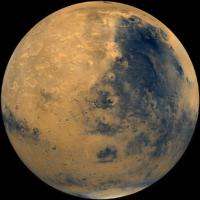Mars or bust, says new report on NASA human space exploration

If NASA is to make great strides in its human spaceflight program, it needs to go big or go home - and get to the Martian surface, says a new congressionally mandated report.
But the 285-page report from the National Research Council goes on to say the agency won't succeed unless it does so in a smart, well-planned way, venturing far beyond the International Space Station in low-Earth orbit with the help of a clear, step-by-step plan.
The report calls for the U.S. to set an ambitious (but not too far-out) goal of reaching the Red Planet's surface by building up the necessary technology and expertise in a series of human exploration missions. This stepping-stone plan could potentially include visiting an asteroid or building an outpost on the moon.
The Obama administration's stated goals for human space exploration are to send a human to an asteroid by 2025, and to Mars by the mid-2030s. But right now, the report's authors said, the U.S. has been a little lost in space, operating without a solid plan.
"There really isn't a strong direction to the human spaceflight program beyond ISS itself, which is in the mature phase," said Jonathan Lunine of Cornell University, co-chairman of the committee that authored the report.
The report, mandated by Congress in the 2010 NASA Authorization Act, doesn't recommend any specific plan, but outlines three example 'pathways' the U.S. can take to get to Mars, each with its own set of strengths and weaknesses.
One option essentially starts with NASA's planned mission to redirect an asteroid to orbit around the Earth, and then moves toward visiting the Martian moons Phobos and Deimos. Another uses the moon as an intermediate stepping stone, which could involve building a lunar base. A third goes to many of these places - an asteroid, the moon, the Martian moons, and then some - basically touring all the nearby spots in the solar system.
That third option would probably be the most expensive but would also hold the least developmental risk because there would be many missions with incremental technology improvements feeding into the following projects, said John C. Sommerer, chairman of the report's technical panel and chief technology officer at Applied Physics Laboratory in Maryland.
"A program worthy of the risk and worthy of the cost has to be ambitious - and Mars has to be the goal," said the committee's other co-chairman, Mitch Daniels Jr., Purdue University's president and a former governor of Indiana. "But we do conclude that we will not get there ... without a new approach."
The report also calls for the United States to look far beyond the limits of the International Space Station. The findings, based on about 18 months of work, come as Russia has announced that it plans to stop using the station after 2020, and amid rising political tensions triggered by turmoil in Ukraine.
Still, long gone are the Cold War days when space exploration was deeply linked to military might in the public and political psyche. There remain aspirational goals, including the survival of the human species and the shared urge to explore the universe. There are also many pragmatic goals, including benefits to the economy, national security, international relations and science education.
And though there isn't one single reason to continue to explore space today, these aspirational and pragmatic goals together provide more than enough reason to reach for Mars, the report's authors said.
Although public opinion has generally been positive toward space exploration, there isn't much popular push to fund such endeavors beyond the inflation rate, Lunine said.
But the report said that if the U.S. is to take its space program to the next level, it will require more funds for the step-by-step missions that will lead to the Martian surface. It will also require, the authors said, more international cooperation - including with China. Current federal law blocks NASA from working on bilateral projects with the Chinese.
Current U.S. goals aren't well aligned with the rest of the world's interests, the authors pointed out - the U.S. is looking at asteroids while countries such as China have been sending probes to the moon.
However, having a clear, well-thought-out plan of exploration over the coming years will make it easier for international partners to work with the United States, they said.
©2014 Los Angeles Times
Distributed by MCT Information Services



















